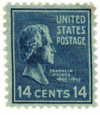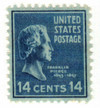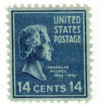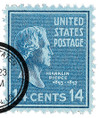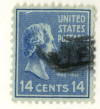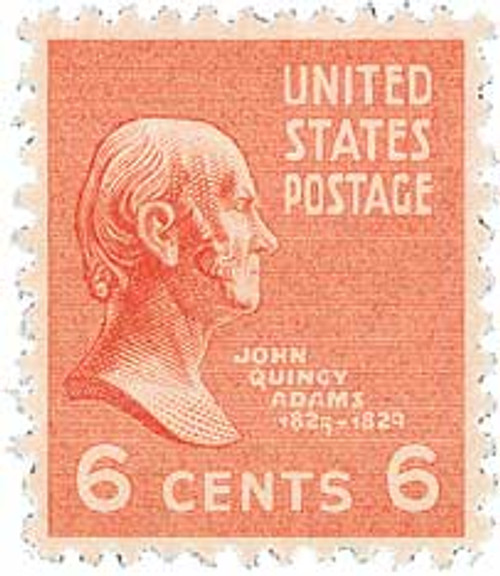U.S. #819
1938 14¢ Franklin Pierce
Presidential Series
Issue Date: October 6, 1938
First City: Washington, DC
Quantity Issued: 289,860,900
Printing Method: Rotary press
Perforations: 11 x 10 ½
Color: Blue
Known affectionately as the “Prexies,” the 1938 Presidential series is a favorite among stamp collectors.
The series was issued in response to public clamoring for a new Regular Issue series. The series that was current at the time had been in use for more than a decade. President Franklin D. Roosevelt agreed, and a contest was staged. The public was asked to submit original designs for a new series picturing all deceased U.S. Presidents. Over 1,100 sketches were submitted, many from veteran stamp collectors. Elaine Rawlinson, who had little knowledge of stamps, won the contest and collected the $500 prize. Rawlinson was the first stamp designer since the Bureau of Engraving and Printing began producing U.S. stamps who was not a government employee.
Franklin Pierce
Modern historians frequently rank Franklin Pierce among America’s worst Presidents, a sentiment that his contemporaries shared. Pierce’s life was a study in contradictions, and his one-term administration hastened the nation’s march to war. By the end of his term, Pierce had alienated Northern voters as well as his own political party, who declined to nominate him for re-election.
After his departure from the White House, Pierce supported President Jefferson Davis of the Confederate States of America and was a vocal critic of Abraham Lincoln.
Franklin Pierce was also a likeable man whose personal life was shattered by overwhelming tragedy. Historians Philip B. Kunhardt and Peter W. Kunhardt summarized the conclusions of many of their colleagues in The American President. Pierce “was a good man who didn’t understand his own shortcomings... popular... good at the political game... timid and unable to cope with a changing America.” Having witnessed the Civil War, the death of his wife, and Lincoln’s assassination, Pierce died of cirrhosis in 1869.
Pierce’s Early Life
Franklin Pierce was born on November 23, 1804, in Hillsborough Lower Village, New Hampshire. Pierce was the first future U.S. President born in the nineteenth century and the only one to hail from New Hampshire.
Franklin’s father, Benjamin Pierce, was a decorated Revolutionary War veteran and active in state politics, including two terms as governor.
At the age of 11, Franklin Pierce was sent to Hancock Academy to study. In the spring of 1820, he transferred to Francestown Academy. Pierce reportedly became homesick and walked home fourteen miles barefoot. His father drove him halfway back to the academy, abandoning Pierce on the side of the road without uttering a word.
Pierce entered Bowdoin College in the fall, where he began a lifelong friendship with Nathaniel Hawthorne and Henry Wadsworth Longfellow. Pierce’s grades were poor at the beginning of his college career, but improved so much he graduated third in his class in 1824. Pierce began studying law under Governor Levi Woodbury and was admitted to the bar in 1827.
Pierce Goes to Washington
Once his law practice was established, Pierce became active in politics and the Democratic party. In 1828, Pierce was elected to the New Hampshire House of Representatives, where he served as Speaker. In 1832, he was elected to the U.S. House of Representatives. At age 27, Pierce was the youngest U.S. Representative to date. Four years later, he was elected to the U.S. Senate.
Following a ten-year courtship, Pierce married Jane Means Appleton in 1834. The couple was opposites in many ways. Pierce was likeable and outgoing, while Jane was quiet and religious. Pierce enjoyed the Washington, D.C. social scene and the alcohol that accompanied it. Jane supported the Temperance Movement and loathed the nation’s capital.
In 1836, the couple’s first son died shortly after birth. Jane Pierce slipped into severe depression, a condition that would worsen throughout her life. To soothe his wife – and possibly to remove himself from the temptation of alcohol – Pierce resigned his position and returned the family to New Hampshire, where he resumed his legal practice. Aside from a two-year term as U.S. Attorney for the District of New Hampshire, Pierce avoided political office. He declined the Democratic nomination for governor and President Polk’s appointment to serve as the Attorney General of the United States.
The Pierce family suffered another devastating loss in 1843, when son Frank Robert died at the age of four from epidemic typhus.
The Mexican War
Pierce enlisted during the Mexican-American War and was quickly promoted to colonel in spite of his meager qualifications. In March of 1847, he was appointed brigadier general and took command of reinforcements for Winfield Scott’s army, which was marching on Mexico City. Pierce and his men reached Scott in time for the Battle of Contreras, where he fell from his horse and suffered a serious leg wound.
The following day, Pierce commanded his men during the Battle of Churubusco until he passed out from the pain and was carried from the field. Although Pierce returned for the rest of the campaign, his political enemies would claim cowardice had driven him from the battlefield.
Once home, Pierce served as president of the 1850 New Hampshire state constitutional convention. In Washington, D.C., lawmakers were passing a complicated package of bills known as the Compromise of 1850. Intended to defuse the growing slavery debate, the package would have long-term implications for the nation and Franklin Pierce.
Dark Horse Nominee
In 1852, Pierce had only minor credentials as a politician and a lackluster military career on his resume. When the Democratic National Convention was held that year, there were four major candidates for the presidential nomination – including Stephen A. Douglas and James Buchanan.
The convention’s first order of business was to adopt the party’s platform. The Democrats chose to oppose any further “agitation” over the issue of slavery, and to support the Compromise of 1850 – including the controversial Fugitive Slave Act – to unite opposing factions within the party.
When voting began, none of the candidates reached the two-thirds majority needed to win the nomination. On the 35th ballot, Pierce’s name was added as an alternative. A firm “Jacksonian” Democrat, Pierce was likeable, popular – and had never taken a public stand on slavery. In a unanimous vote, the relatively unknown candidate from New Hampshire was nominated on the 49th ballot. Jane Pierce fainted when she heard the news.
Alabama Senator William R. King was selected as Pierce’s running mate. King had a long record of government service and was President pro tempore of the Senate at the time of his nomination. In the debates leading to the Compromise of 1850, King had supported a Senate gag rule against debate on antislavery petitions and opposed the abolition of slavery in the District of Columbia.
Pierce’s running mate lived with James Buchanan, an arrangement of fifteen years. Their close relationship led critics to call King “Aunt Fancy,” and the couple “Buchanan and his wife.” The nature of their relationship may never be known; however, the men clearly shared a deep affection. When King traveled to France, Buchanan wrote, “I am now solitary and alone, having no companion in the house with me. I have gone a wooing to several gentlemen, but have not succeeded with any one of them. I feel it is not good for man to be alone...”
In spite of the potential for scandal, the Pierce-King ticket apparently satisfied factions within the Democratic party. Southerners had an anti-abolitionist in King, and Pierce had avoided offending anyone by keeping his views private.
In the national election, Pierce faced General Winfield Scott, the Whig Party candidate under whom he had served in the Mexican-American War. The two parties’ platforms were nearly identical, causing the presidential race to become more of a personality contest. The Whigs campaigned on Pierce’s obscurity, which was a strategy that had cost them the White House in 1844. Scott’s anti-slavery stance cost him votes in the South, while Pierce received support from the Irish Catholic Democrats.
On election day, Pierce prevailed in 27 states – including Scott’s home state of Virginia. It was one of the largest electoral victories in U.S. history.
Grief Casts a Shadow Over the White House
On December 20, King resigned his position in the Senate because of ill health and went to Cuba. A few days later, a railroad car the Pierce family was traveling in derailed. Franklin and Jane watched helplessly as their only surviving child was crushed to death – the only fatality of the accident. Jane Pierce blamed political ambitions for the loss of her son and sunk deeper into depression.
Aged 48 at the time of his inauguration, Pierce was the youngest President up to that time. He elected to affirm his oath of office rather than swear on a Bible, becoming the first President to do so. Pierce was also the first to recite his entire inaugural speech from memory. In it, President Pierce spoke of the era of domestic peace and prosperity and urged Americans to assert U.S. interests abroad. He also addressed slavery by saying, “I believe that involuntary servitude, as it exists in different States of this Confederacy, is recognized by the Constitution.”
Jane didn’t attend the ceremony and inaugural celebrations were canceled out of respect for the grieving family. The White House hadn’t been prepared for Pierce’s arrival. Without so much as a bed to sleep in, the new President of the United States curled up and went to sleep in a chair.
Terminally ill with tuberculosis, Vice President King took his oath of office in Cuba on March 24, 1853. The unusual arrangements were allowed by a special act of Congress because of the dying man’s lengthy service to his country. King died after serving 45 days in office. Pierce served the rest of his presidency without a vice president.
Presidency
Although Pierce was deeply affected by the tragedies in his life, his administration began on a hopeful note. The Compromise of 1850 seemed to have eased tensions about the issue of slavery, leading to a period of peace and economic growth. Pierce assembled a Cabinet made of men with differing opinions, including Secretary of War Jefferson Davis, the future President of the Confederate States of America. His complete Cabinet stood by his side for the entire four-year term, making it the only presidential cabinet in history to do so. However, Pierce’s weak leadership skills, poor decision making, and position on slavery quickly angered his constituents.
As the nation became more divided and frustrated, Pierce’s government became more ineffective. His support of slavery became evident shortly after his inauguration, with several policy decisions that caused the North-South rift to widen. Pierce believed the Compromise of 1850 had satisfied the slavery issue. He strictly enforced the Fugitive Slave Act, a section of the compromise that allowed Southern slaveholders to recapture runaway slaves in Northern states.
This policy inspired the wrath of Harriet Beecher Stowe, whose novel about the Underground Railroad, Uncle Tom’s Cabin, was causing a sensation across the nation. Many readers called for the repeal of the controversial act – but Pierce refused.
Northerners were also enraged by the Ostend Manifesto. Believing the Spanish colony of Cuba was about to free its slaves or be overthrown by a slave revolt, pro-slavery forces urged Pierce to purchase the island for the United States. The President authorized his representative in Spain to begin negotiations. With the help of future President James Buchanan, the Ostend Manifesto offered to pay $120,000 for Cuba. However, it also warned the U.S. would seize the island by force if needed. An international uproar occurred when details of the manifesto were leaked to the public. As the negotiations fell through, Pierce tried to distance himself from the scandal.
Pierce was further damaged by the debate over the Gadsden Purchase and the 1854 passage of the Kansas-Nebraska Act. Pierce’s Cabinet proposed an alternative plan, but Stephen A. Douglas and several Southern senators persuaded him to support it in a closed meeting. The act repealed the Missouri Compromise, reopening the question of slavery in the West.
The Kansas-Nebraska Act allowed residents of the new territories to decide the question of slavery for themselves, triggering a series of deadly events known as “Bleeding Kansas.” Pro-slavery activists and abolitionists flooded into the region. The Border Ruffians, a pro-slavery group from Missouri, voted in an illegal government that Pierce formally recognized. The anti-slavery “Free-Staters” set up a shadow government, which Pierce labeled an act of rebellion. Federal troops were eventually dispatched to the region.
Tension grew steadily and the public became more frustrated with Pierce’s ineffectiveness. After being attacked with a hard-boiled egg, Pierce became the first U.S. President to have a full-time bodyguard. Pierce’s chance for re-election was dashed when members of the 1856 Democratic National Convention chose James Buchanan as their presidential nominee.
Personal Life
Known as the “Shadow of the White House,” Jane Pierce was shy and reclusive by nature. Jane avoided Washington, D.C. society and performed few functions as First Lady. Her widowed aunt, Abigail Kent Means, performed most of her official duties along with Varina Howell Davis, the wife of Jefferson Davis. Much of Jane’s time was spent writing letters to her deceased son, Benjamin.
Although she blamed her husband’s political aspirations for the deaths of her sons, Jane did have firm beliefs of her own. While her husband supported the institution of slavery, Jane believed in abolition and persuaded Pierce to release a prominent abolitionist from a Kansas prison.
After leaving Washington, D.C., the couple sailed to the Caribbean on board the U.S.S. Powhatan, a government ship loaned to them by newly elected President James Buchanan. From there they sailed to Europe, where Jane’s depression became chronic and she contracted tuberculosis. The Pierces returned home in 1860, where Jane became even more reclusive and Franklin battled alcoholism. Jane died in her sister’s home in 1863.
Aftermath
Like Millard Fillmore and Franklin Pierce before him, President James Buchanan was a Northern Democrat who supported the rights of states to determine the slavery issue. And also like them, Buchanan was overwhelmed by the mounting threat of civil war. Abolitionist sentiments grew quickly in the late 1850s, giving rise to the Republican Party and the election of Abraham Lincoln in 1860.
Lincoln’s election prompted several states to secede and form the Confederate States of America. Shortly before sunrise the morning of April 12, 1861, the first shots of the Civil War were fired at Fort Sumter. Over 618,000 Americans died during the four-year conflict, making it the deadliest in U.S. history.
With the exception of an occasional public criticism of Lincoln, Franklin went into near-seclusion after Jane’s death and passed away in 1869, leaving no descendants.
Death Of Nathaniel Hawthorne
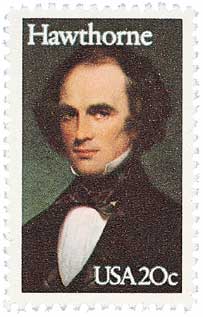
American novelist Nathaniel Hawthorne died on May 19, 1864, while on a trip with former president Franklin Pierce to the White Mountains in New Hampshire.
Nathaniel Hawthorne was born on July 4, 1804, in Salem, Massachusetts. In 1816, Hawthorne’s family moved to Maine. He greatly enjoyed his time there, saying they were “delightful days, for that part of the country was wild then, with only scattered clearings.”
In his teens, Hawthorne produced a handwritten newspaper called The Spectator for his family, which featured his own essays, poems, and news stories. In 1821, Hawthorne’s uncle insisted he go to college, though Hawthorne didn’t want to. On his way to Bowdoin College, Hawthorne met future president Franklin Pierce, and the two began a life-long friendship. Hawthorne was an unenthusiastic student but graduated in 1825.
By 1836, Hawthorne was working as the editor for the American Magazine of Useful and Entertaining Knowledge. Some of his short stories were printed in magazines and annuals, but none earned him major recognition. Then in 1837, a friend offered to pay to have his works collected into a volume titled Twice-Told Tales, which earned him some local attention.
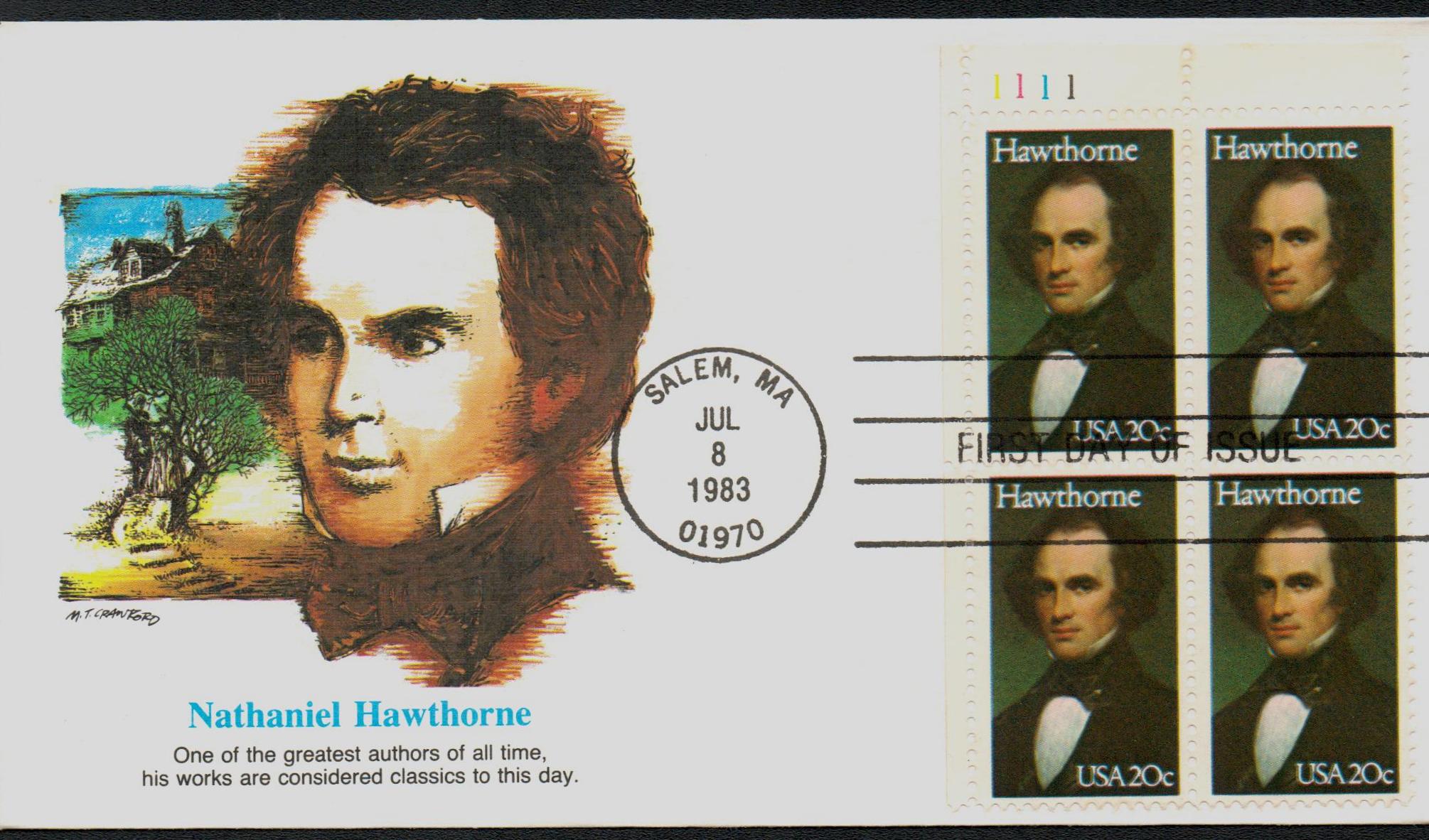
In the 1840s, Hawthorne worked in a customs house and as surveyor and inspector of the revenue in Salem. During these periods, he found it difficult to write. He also grew frustrated with politics, especially after he lost his job following a presidential election. He shared his feelings in a letter in the Boston Daily Advertiser and earned some local support.
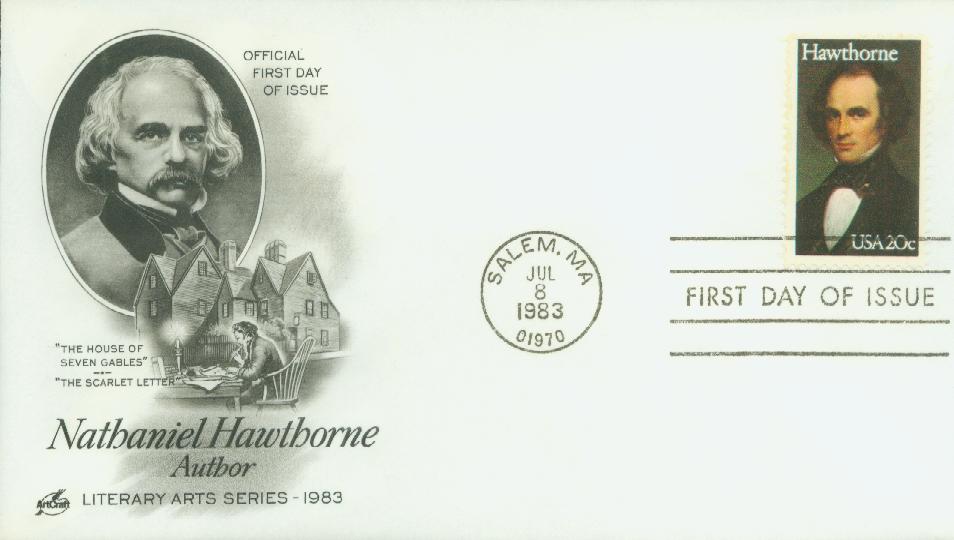
Hawthorne eventually found himself able to write again and in March 1850, he published The Scarlet Letter. It quickly became a best seller and sold 2,500 copies in 10 days. It also marked the start of the most productive and successful era of Hawthorne’s career. Later in 1850, Hawthorne befriended Herman Melville, who was writing Moby-Dick at the time. When published, he dedicated the story to Hawthorne “In token of my admiration for his genius.”
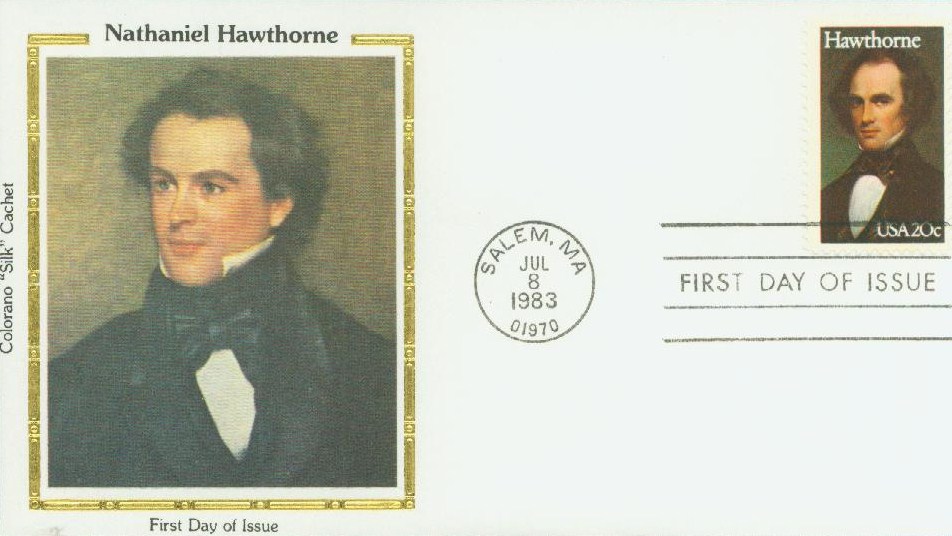
Hawthorne followed his first success with another, The House of Seven Gables, in 1851. One critic said it was better than The Scarlet Letter and said it was “the most valuable contribution to New England history that has been made.” The book was partially based on the true story of a curse put on his family by a woman condemned to death during the Salem witch trials.
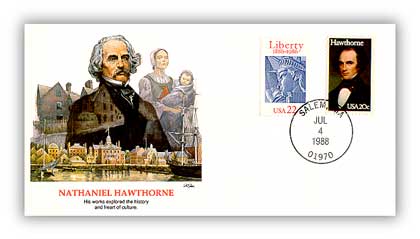
In 1853, Hawthorne purchased a home in Concord, Massachusetts, which he named The Wayside. While there, he wrote a biography of Franklin Pierce, who was running for president at the time. Hawthorne hoped it would help convince Americans that Pierce would make a good president, though Horace Mann said it was “the greatest work of fiction he ever wrote.”
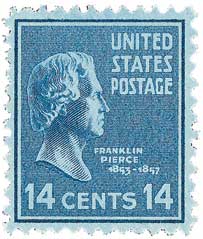
Pierce won that presidential election and made Hawthorne US consul in Liverpool in 1853. It was a highly prized position that Hawthorne enjoyed until Pierce’s administration ended in 1857. After spending some time in France and Italy, Hawthorne’s family returned home in 1860 and he published The Marble Faun.
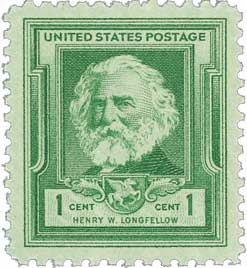
By the 1860s, Hawthorne was in ill health, but in 1864, he wanted to go on a vacation with Pierce to the White Mountains in New Hampshire. He died in his sleep during that trip on May 19, 1864. His longtime-friend Henry Wadsworth Longfellow wrote a poem in his honor in 1866, called “The Bells of Lynn.”
Click here to view some of Hawthorne’s works.




















